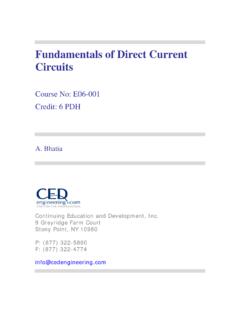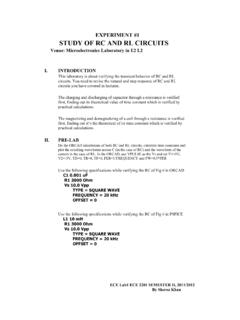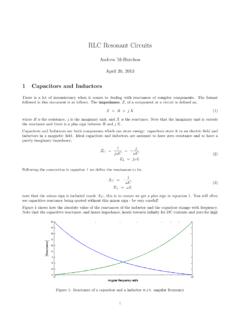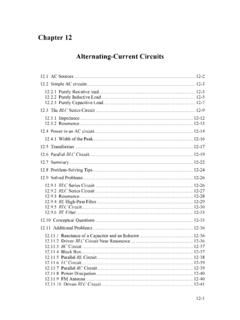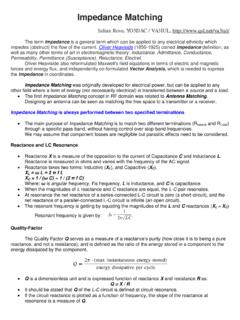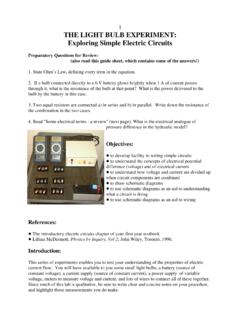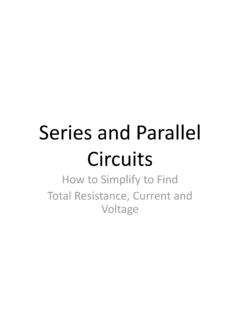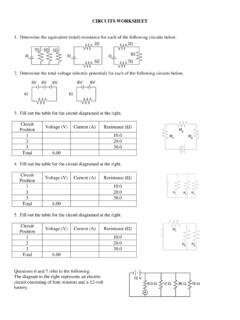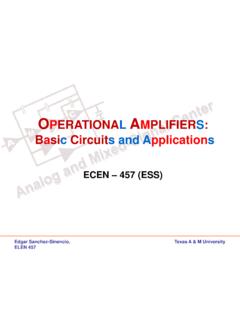Transcription of Chapter 24: Alternating-Current Circuits
1 Chapter 24: Alternating-Current Circuits 2. The voltage in the European wall socket oscillates between the positive and negative peak voltages, resulting in an rms voltage of 240 V. Multiply the rms voltage by the square root of two to calculate the peak voltage. Calculate the peak voltage: Vmax 2 Vrms 2 240 V 340 V. 6. A light bulb dissipates power as the voltage oscillates across its filament resistance. Calculate the resistance from the average power and the rms voltage using equation 21-6. Then, from the resistance and rms voltage, solve for the rms current using Ohm's Law (equation 21-2). Convert the rms current to maximum current by multiplying it by the square root of two. Finally, use the resistance and maximum current to calculate the peak power dissipation. 120 V . 2. Vrms 2. 1. (a) Solve equation 21-6 for R: R 190 . Pav 75 W. Vrms 120 V. 2. (b) Use Ohm's Law to calculate I rms : I rms A.
2 R 192 . 3. Convert to peak current : I max 2 I rms 2 A A. R A 192 150 W kW. 2. 4. (c) Calculate maximum power: Pmax I max 2. 10. A capacitor connected in series with an oscillating voltage source limits the current in the circuit . Solve equation 24-9 for the capacitive reactance, and then insert the capacitive reactance into equation 24-8 to calculate the rms current . 1 1. 1. Calculate the capacitive reactance: XC . C 2 s 1 105 F.. Vrms V. 2. Solve for the rms current : I rms A. XC . 13. An oscillating voltage drives an alternating current through a capacitor as in the circuit depicted at the right. Calculate the capacitive reactance using equation 24-9 and insert it into equation 24-8 to calculate the maximum voltage. Calculate the phase angle for which the current is A using equation 24-2. Insert the phase angle into the equation V Vmax sin 90 to calculate the voltage.
3 1. (a) Calculate 1 1. XC . the capacitive reactance: C 2 120 s 1 22 F.. 2. Insert X C into equation 24-8: Vmax X C I max A V. 1. 3. (b) Calculate the phase angle : I I max sin . I A. sin 1 sin 1 or 138 . I max A. 4. Calculate V when I is increasing ( ): V Vmax sin 90 V sin 90 V. 5. (c) Calculate V when I is decreasing ( 138 ): V V sin 138 90 V. 21. An oscillating voltage drives an alternating current through both a capacitor and a resistor that are connected in series . Divide the rms voltage by the rms current to calculate the impedance Z of the circuit . Insert the impedance into equation 24-11 and solve for the resistance. Vrms 95 V. 1. Calculate Z: Z 130 . I rms A. 2. 1 . 2 1 . 130 k . 2. 2. Solve equation 24-11 for R: R Z 2.. C 2 150 s 13 10 F . 1 6. 22. An oscillating voltage drives an alternating current through both a capacitor and a resistor that are connected in series .
4 Solve equation 24-11 for the impedance Z of the circuit . Divide the rms voltage by the impedance to calculate the rms current . Solve equation 24-12 for the phase angle . 2. 1 . 2 1 . k k . 2. 1. (a) Calculate Z: Z R . 2.. C 2 65 s F . 1. Vrms 135 V. 2. Find the rms current : I rms mA. Z k . R k . 3. (b) Solve equation 24-12 for : cos 1 cos 1 . Z k . 32. An oscillating voltage drives an alternating current through both an inductor and a resistor that are connected in series . Use equation 24-15 to calculate the impedance of the circuit , and then divide the rms voltage by the impedance to calculate the rms current . 525 2 Hz H . 2. Z R 2 2 L2 . 2. 1. Calculate the impedance: Vrms V. 2. Divide the voltage by the impedance: I rms mA. Z . 36. An oscillating voltage drives an alternating current through an inductor. Divide the rms voltage by the reactance (given by equation 24-14) to calculate the rms current .
5 Set the current less than mA and solve for the possible range of frequencies. 2. Vrms Vrms Vrms 1. Calculate I rms in terms of f : I rms mA. XL L 2 f L. Vrms 12 V. 2. Solve for the frequency range: f GHz 2 L mA 2 H mA . 3. Write out the frequency range: GHz < f . 48. An oscillating voltage drives an alternating current through a resistor, an inductor, and a capacitor that are all connected in series . Calculate the rms voltage across each element by multiplying the reactance or resistance of each element by the rms current . To calculate the rms current , divide the rms voltage by the impedance, given by equation 24-16. 1 1. 1: Calculate X C : XC . C 2 Hz F. k . 2. Calculate X L : X L L 2 Hz 25 mH . Z R 2 X L X c ( k ) 2 k k . 2 2. 3. Calculate the impedance: k . 4. Divide the voltage by Vrms 115 V. I rms mA. the impedance: Z k . 5. Multiply the current by Vrms, R I rms R mA k 56 V.
6 The resistance: Vrms, L I rms X L mA 54 mV. 6. Multiply the current by the inductive reactance: Vrms, C I rms X C mA k 100 V kV. 7. Multiply the current by the capacitive reactance: 50. The image shows an inductor (L = mH) in series with a 15- resistor. These elements are in parallel with a second 15- resistor. An ac generator powers the circuit with an rms voltage of 65 V. In the limit of high frequency, the inductor behaves like a very large resistor. In such a case nearly all of the current flows through the branch with the lone resistor. Calculate the current by dividing the rms voltage by the single resistor. In the limit of low frequency, the reactance of the inductor approaches zero. In such a case the current flows through each resistor equally. Use equation 21-10 to calculate the equivalent resistance and divide the voltage by the equivalent resistance to determine the current .
7 Vrms 65 V. 1. (a) Calculate the current at high frequency: I rms A. R 15 . 1. 1 1 R 15 . 2. (b) Calculate the equivalent resistance at low frequency: Req . R R 2 2. Vrms 65 V. 3. Divide the voltage by the equivalent resistance: I rms A. Req . 3. 52. An oscillating voltage drives an alternating current through a resistor, an inductor, and a capacitor that are all connected in series . First calculate the capacitive reactance (equation 24-9) and the inductive reactance (equation 24-14) of the circuit using the given values. Then use these in equation 24-17 to calculate the phase angle. 1 1. 1: Calculate the capacitive reactance: XC k . C 2 Hz F. 2. Calculate the inductive reactance: X L L 2 Hz 250 mH . XL XC 1770 . 3. Solve equation 24-17 for the phase angle: tan 1 tan 1 . R 9900 . 4.










